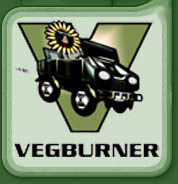Heating
The Oil
Version 2.0 (19/4/2004)
Heating the Oil- Version 1.0
Heating the Oil- Version 1.1
1 The Diesel Engine
2 Theory of Vegetable Oil Use as a
Fuel
3 Engine suitability
4 Heating the Oil
5 Biodiesel
6 Micro Emulsions and Blends
7 Vegetable Oil Engine Design
8 Vegetable Oil Furnaces and Heaters
9 Oil Types and Filtering
10 Taxation
11 Implications of Vegetable Oil
Fuel Use
12 Sources
Heating The Oil
Vegetable oil can be used in a diesel engine if it is heated
to reduce its viscosity so that it will perform in a similar
fashion to diesel fuel
A number of studies and ever growing empirical experiences
have shown that the use of such systems with many engines
can give operating characteristics and reliability similar
to when running diesel fuel. Emissions and power have been
shown to be comparable or improved.[2][23]
When environmental, production, social and economic considerations
of the use of biofuels for transportation fuels has been considered,
studies have found straight vegetable oil to be the most suitable
energy source.[16][17][24]
Vegetable Oil Conversion Design
When designing a fuel heating system a number of factors
need to be considered to ensure reliable operation:-
direct / indirect fuel injection
rotary / inline injector pump
ambient temperatures encountered
type of oils to be used
computer / mechanical controlled injection
The time when problems are most likely to occur is when
the engine is being started from cold. The engine does not
have the latent heat that would aid combustion and the engine
may not fire.
A growing number of companies offer conversion kits and conversion
services that allow vegetable oil to be poured into the tank
instead of diesel. These kits use electric heating and often
replacement injectors to ensure that the right conditions
for combustion can be obtained.
The Twin Tank or Duel Fuel System
A simple and effective way to safely run
on vegetable oil is to run a duel fuel system. The engine
is started on petro-diesel (or bio-diesel etc) and the waste
heat created by the engine is used to heat the vegetable oil.
This avoids running vegetable oil through a cold engine at
start up. A temperature gauge in the fuel line allows you
to see when the oil is hot enough for the fuel supplies to
be switched.
The fuel supply is switched by a three way valve. Before shutting
down for extended periods the fuel supply is switched back
and the engine is allowed to run for a few minutes (approx
3-5mins depending on set-up) so that the vegetable oil is
flushed from the fuel system. The vehicle is then ready to
be restarted on diesel fuel. Placing the fuel selection valve
as close to the injector pump as possible reduces the flushing
time.
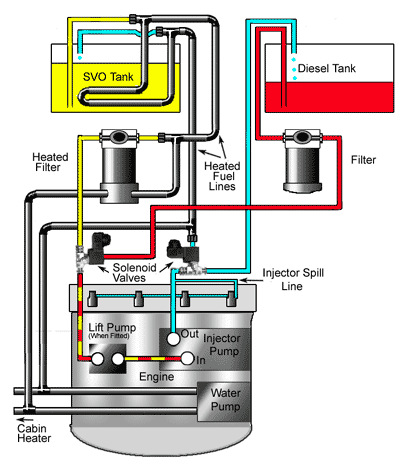
Twin Tank Fuel System
Fuel Return
In most engines the injector pump is supplied by the transfer
pump with more fuel than is required. The excess fuel is generally
returned to the fuel tank although some engines recycle the
excess back to the injector pump.
When running a duel fuel system the commonly utilised ‘return
to tank’ system will require modification. Getting vegetable
oil returned into the diesel tank can be undesirable as it
will accumulate and would cause problems associated with running
unheated SVO. Getting diesel in the vegetable oil is not a
problem mixing diesel into vegetable oil improves its performance.
Having a three way valve in the return line allows fuels
to be sent to the appropriate tank. Especially with thick
oils, care should be taken to feed back to the diesel tank
only after vegetable oil has been purged from the system avoiding
diesel tank contamination. When using oils with high melt
points this has proven to be less of an issue.
Having a single return to the vegetable oil tank is another
possibility but diesel would be pumped into the vegetable
oil tank when the vehicle was running on diesel, in the wrong
circumstances this could lead to an overflowing tank.
Another option is to run this fuel, by using a T connector,
into the injector pump intake line. There is the possibility
of a build up of air due to slight leaks and the closed circuit
giving the air nowhere to vent. Excessive air would lead to
the engine being starved of fuel, as well as the possibility
of the injector pump which uses the fuel oil for lubrication
being damaged. A device that allowed trapped air to escape
introduced to this closed loop would offer a solution. Many
examples of this fuel system configuration have been utilised
without problems. Extra care is required to ensure all pipe
connections, filter seals etc. are air tight.
This method offers the advantage of mixing the fuel returned
from the injectors, which has been heated through compression
in the injector pump and contact with the engine, with the
fresh fuel supply. Upon switching the vegetable oil is gradually
mixed with the hot diesel, the vegetable oil percentage increasing
as the remaining diesel fuel is used. A mixture of fuels is
more prone to combust completely at lower temperatures allowing
the SVO to be introduced sooner. Also the volume of fuel being
pulled from the fuel tank is reduced to the amount of fuel
consumed by the engine. This reduces the amount of work the
transfer pump has to perform which also reduces the level
of suction ‘up stream’ of the pump making air
ingress less likely.
The time required to run on diesel before the fuel supply
can be safely switched to SVO is dependant on engine design,
fuel characteristics, heating equipment, ambient temperature,
engine temperature and fuel system design. Assessing exactly
when to switch the fuel supply can be achieved by a process
of gradual reduction, monitoring for undesirable engine run
characteristics and if possible fuel temperature and vacuum/pressure.
A vacuum gauge fitted before a transfer pump will show if
the pump is performing excessive work pulling cold oil.
Heating Methods
Cold weather is a problem with diesel fuel as it can begin
to solidify below -7°C and will block the fuel filter
[11]. Products that use heat to aid diesel fuel flow in cold
weather are available and many are suitable for application
in a SVO system. Sometimes it may be appropriate to ‘tune’
these products as they are generally designed to heat to a
temperature below that which is desirable with an SVO system.
Heating systems specifically designed to be used in SVO systems
are available or can be fabricated.
Engine Coolant Heat
These units are utilised on liquid cooled engines. The hot
engine coolant fluid is used to heat the vegetable oil. The
coolant in an engine generally runs between about 75 and 90°C
(158-203°F) so it is at a suitable temperature to heat
the SVO via a heat exchanger. There are many examples of successful
coolant heated vegetable oil fuel systems.
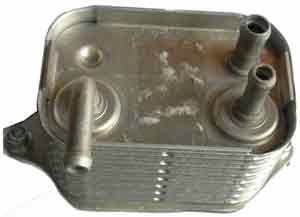
Plate Type Coolant/Fuel Heat Exchange: shows two fuel and
one coolant connector with second coolant connection underneath.
Alternate layers of fuel and coolant give a large contact
surface area giving a good efficiency.
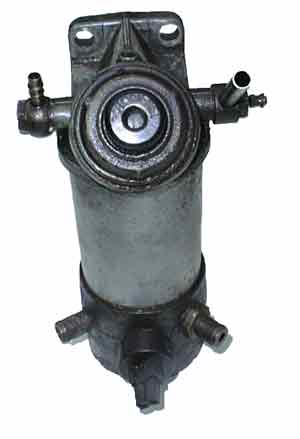
CAV Filter with Coolant Heated Base
Engine Oil Heat
Hot engine oil is used to heat the veg oil. Engine oil will
heat to above 100° so may be a better option than coolant
in some applications. Leaks in the oil system are much more
likely to be terminal for the engine. Great care should be
taken to avoid engine oil leaks.
Exhaust Heat
The heat from gasses in the engine exhaust system can be
used to heat the fuel.
A reported system used metal fuel line wrapped around the
exhaust system of a genset. As a generator engine runs at
a steady rate using a steady fuel flow heat was regulated
by the number of turns around the exhaust. The unit was not
dual fuel and there were some problems with cold starting.
Using this heat source in a dual fuel system could lead to
problems overheating the oil before switching.
Systems have been proposed using a valve to allow a regulated
exhaust gas flow away from the existing exhaust system and
into other piping where the hot gasses are used to heat the
vegetable oil. The valve opening could be regulated to give
the required amount of heating. An idea with potential considering
the very quick heating times that could be achieved.
Returned Fuel Heat
As discussed above the fuel returned from the injectors
has been heated through compression in the injector pump and
high pressure lines and from contact with the hot injector.
The heat of the fuel can be used by T-ing the return into
the fuel supply as described, by sending it to the SVO tank
or through a heat exchanger with the incoming fuel.
Electrical Heat
An electrical heating element can be used
to heat up the oil to suitable temperatures. In a vehicle
application care has to be taken not to have a power demand
that would be excessive for a given electrical system. Rapid
heating is possible with an electric heater allowing a dual
fuel system fuel supply to be switched sooner. A suitably
modified engine equipped with electrical heaters can be started
and run on SVO alone.
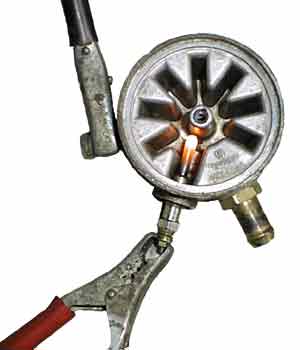
Demonstration of Glow Plug Fitted to a
Coolant Heated Filter Base
For Electrical Heating Capability
Injector Pump Heating
Assessment of the first vehicle converted using a dual fuel
system showed the possibility of insufficiently heated oil
running through the engine and causing crud build ups in the
cylinders and on the injectors. The perceived problem was
when the fuel supply was switched from petro-diesel to vegetable
oil. The hot vegetable oil would rush into the fuel injection
pump, which was considerably cooler than the oil, cool down
and then get injected into the engine at a temperature below
that which would be desirable.
The engine was equipped with a CAV rotary pump, known to
be less durable when pumping SVO, and there was the possibility
of damage from the increased heat generated pumping the thicker
oil.
A method of heating the injector pump was devised. Both fuel
supplies were heated with coolant before the injector pump.
This way the injector pump would be gradually warmed by the
heated diesel fuel before switching to vegetable oil. To avoid
the possibility of fire care should be taken to ensure a fuel
heated above its flash point can not leak from the fuel system.
Some engines (some Mercedes etc.) use engine oil to lubricate
the injector pump which provides heat to the pump.
Vegetable Oil Tank and Lines
Depending on the type of oil used and at what ambient temperature,
the fuel tank, lines and filter may need heating to allow
free flowing of fuel. At low temperatures SVO will be thick
or solid and hard or impossible to pump. The filter is a definite
bottle neck. SVO will flow more freely through thicker fuel
pipe.
Having a filter system for each of the fuel supplies will
reduce the amount of fuel that needs to be flushed when changing
fuel supplies. If a filter becomes blocked due to waxing or
impurities the vehicle can still be run on the second fuel
system.
Some proponents advocate using a more course filter in the
vegetable oil line to allow thick oils to flow at the desired
rate and help to reduce waxing. This has to be balanced against
the increased size of particles that may pass through the
filter and cause wear to the injector pump. Heating the vegetable
oil in, or up stream, of the filter will help the fuel flow
and reduce the possibility of waxing the filter.
Diesel Fuel Return
Having a valve which allows the diesel fuel to be returned
back down the vegetable oil feed through the filter will act
to clean the filter, pushing any particles off the filter
media and into the filter base or back to the veg oil tank.
A drain plug at the bottom of the fuel tank or filter base
allows settled particles/water to be evacuated.
Pre Heating the Engine
Electric, diesel, biodiesel, propane and petrol fired engine
pre-heaters are available that are switched on for approximately
half an hour before starting the engine. They heat the engine
coolant and pump it around the system, sometimes using a thermo
siphon technique providing heat for the engine cabin heater
and any coolant/fuel heat exchanger fitted.
An engine thus heated will be easier to start under adverse
conditions due to the extra heat in the combustion chamber.
Fuel inside a heat exchanger would be up to temperature before
the engine was started. These units also reduce emissions
and engine wear connected with cold engine running.
1 The Diesel Engine
2 Theory of Vegetable Oil Use as a
Fuel
3 Engine suitability
4 Heating the Oil
5 Biodiesel
6 Micro Emulsions and Blends
7 Vegetable Oil Engine Design
8 Vegetable Oil Furnaces and Heaters
9 Oil Types and Filtering
10 Taxation
11 Implications of Vegetable Oil
Fuel Use
12 Sources
|
